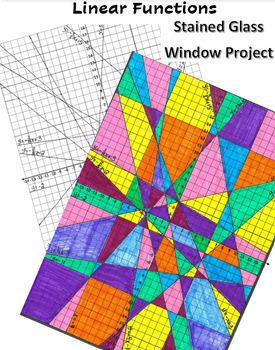Linear Functions Stained Glass Project
- Zip
Description
My students love doing this project! I have a large portion of EL students in my Pre-Algebra class. It lets them demonstrate their understanding of writing, graphing, and comparing linear functions in a format that is less intimidating than a traditional test. It usually takes two, 80 minute, class periods to complete. If you have shorter class periods, you may need to adjust accordingly.
This project is a comprehensive review of linear functions. Students will determine the slope and y-intercept of a function in a variety of contexts and then write the equation of the line in slope-intercept form. This includes:
- Story Problems
- Tables
- Slope and a Point
- Two Points
Slopes will be positive, negative, zero, and undefined.
Once they've written all sixteen linear functions, they will graph them on the graph paper provided. There is both labeled and unlabeled versions. They will trace over their graphs and create a beautiful piece of stained glass!
The project also includes a section where students are comparing linear functions. The key for both the written work and graph, along with a rubric breakdown, and sample graph are included.





